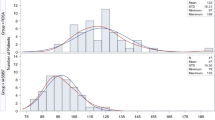Abstract
Purpose
The authors performed this study to compare the outcomes of robotic-assisted and conventional TKA in same patient simultaneously. It was hypothesized that the robotic-assisted procedure would produce better leg alignment and component orientation, and thus, improve patient satisfaction and clinical and radiological outcomes.
Methods
Thirty patients underwent bilateral sequential total knee replacement. One knee was replaced by robotic-assisted implantation and the other by conventional implantation.
Results
Radiographic results showed significantly more postoperative leg alignment outliers of conventional sides than robotic-assisted sides (mechanical axis, coronal inclination of the femoral prosthesis, and sagittal inclination of the tibial prosthesis). Robotic-assisted sides had non-significantly better postoperative knee scores and ROMs. Robotic-assisted sides needed longer operation times (25 min, SD ± 18) and longer skin incisions. Nevertheless, postoperative bleeding was significantly less for robotic-assisted sides.
Conclusion
The better alignment accuracy of robotic TKA and the good clinical results achieved may favorably influence clinical and radiological outcomes.
Level of evidence
I.


Similar content being viewed by others
References
Bathis H, Perlick L, Tingart M, Perlick C, Luring C, Grifka J (2005) Intraoperative cutting errors in total knee arthroplasty. Arch Orthop Trauma Surg 125:16–20
Bellemans J, Vandenneucker H, Vanlauwe J (2007) Robot-assisted total knee arthroplasty. Clin Orthop Relat Res 464:111–116
Decking J, Theis C, Achenbach T, Roth E, Nafe B, Eckardt A (2004) Robotic total knee arthroplasty: the accuracy of CT-based component placement. Acta Orthop Scand 75:573–579
Delp SL, Stulberg SD, Davies B, Picard F, Leitner F (1998) Computer assisted knee replacement. Clin Orthop Relat Res 354:49–56
Fadda M, Marcacci M, Toksvig-Larsen S, Wang T, Meneghello R (1998) Improving accuracy of bone resections using robotics tool holder and a high speed milling cutting tool. J Med Eng Technol 22:280–284
Griffin FM, Insall JN, Scuderi GR (2000) Accuracy of soft tissue balancing in total knee arthroplasty. J Arthroplasty 15:970–973
Jeffery RS, Morris RW, Denham RA (1991) Coronal alignment after total knee replacement. J Bone Joint Surg Br 73:709–714
Jenny JY, Clemens U, Kohler S, Kiefer H, Konermann W, Miehlke RK (2005) Consistency of implantation of a total knee arthroplasty with a non-image-based navigation system: a case-control study of 235 cases compared with 235 conventionally implanted prostheses. J Arthroplasty 20:832–839
Laskin RS (2001) The Genesis total knee prosthesis: a 10-year followup study. Clin Orthop Relat Res 388:95–102
Laskin RS (2003) New techniques and concepts in total knee replacement. Clin Orthop Relat Res 416:151–153
Laskin RS, Rieger MA (1989) The surgical technique for performing a total knee replacement arthroplasty. Orthop Clin North Am 20:31–48
Lutzner J, Krummenauer F, Wolf C, Gunther KP, Kirschner S (2008) Computer-assisted and conventional total knee replacement: a comparative, prospective, randomised study with radiological and CT evaluation. J Bone Joint Surg Br 90:1039–1044
Mahaluxmivala J, Bankes MJ, Nicolai P, Aldam CH, Allen PW (2001) The effect of surgeon experience on component positioning in 673 press fit condylar posterior cruciate-sacrificing total knee arthroplasties. J Arthroplasty 16:635–640
Maniar RN, Johorey AC, Pujary CT, Yadava AN (2011) Margin of error in alignment: a study undertaken when converting from conventional to computer-assisted total knee arthroplasty. J Arthroplasty 26:82–87
Matsen FA 3rd, Garbini JL, Sidles JA, Pratt B, Baumgarten D, Kaiura R (1993) Robotic assistance in orthopaedic surgery. A proof of principle using distal femoral arthroplasty. Clin Orthop Relat Res 296:178–186
Mielke RK, Clemens U, Jens JH, Kershally S (2001) Navigation in knee endoprosthesis implantation–preliminary experiences and prospective comparative study with conventional implantation technique. Z Orthop Ihre Grenzgeb 139:109–116
Novotny J, Gonzalez MH, Amirouche FML, Li YC (2001) Geometric analysis of potential error in using femoral intramedullary guides in total knee arthroplasty. J Arthroplasty 16:641–647
Park SE, Lee CT (2007) Comparison of robotic-assisted and conventional manual implantation of a primary total knee arthroplasty. J Arthroplasty 22:1054–1059
Petersen TL, Engh GA (1988) Radiographic assessment of knee alignment after total knee arthroplasty. J Arthroplasty 3:67–72
Plaskos C, Hodgson AJ, Inkpen K, McGraw RW (2002) Bone cutting errors in total knee arthroplasty. J Arthroplasty 17:698–705
Rand JA, Coventry MB (1988) Ten-year evaluation of geometric total knee arthroplasty. Clin Orthop Relat Res 232:168–173
Reed SC, Gollish J (1997) The accuracy of femoral intramedullary guides in total knee arthroplasty. J Arthroplasty 12:677–682
Ritter MA, Faris PM, Keating EM, Meding JB (1994) Postoperative alignment of total knee replacement. Its effect on survival. Clin Orthop Relat Res 299:153–156
Rodriguez JA, Bhende H, Ranawat CS (2001) Total condylar knee replacement: a 20-year followup study. Clin Orthop Relat Res 388:10–17
Saragaglia D, Picard F, Chaussard C, Montbarbon E, Leitner F, Cinquin P (2001) Computer-assisted knee arthroplasty: comparison with a conventional procedure. Results of 50 cases in a prospective randomized study. Rev Chir Orthop Reparatrice Appar Mot 87:18–28
Scott WN, Rubinstein M, Scuderi G (1988) Results after knee replacement with a posterior cruciate-substituting prosthesis. J Bone Joint Surg Am 70:1163–1173
Siebert W, Mai S, Kober R, Heeckt PF (2002) Technique and first clinical results of robot-assisted total knee replacement. Knee 9:173–180
Sparmann M, Wolke B, Czupalla H, Banzer D, Zink A (2003) Positioning of total knee arthroplasty with and without navigation support—A prospective, randomised study. J Bone Joint Surg Br 85B:830–835
Takahashi T, Wada Y, Yamamoto H (1997) Soft-tissue balancing with pressure distribution during total knee arthroplasty. J Bone Joint Surg Br 79B:235–239
Van Ham G, Denis K, Vander Sloten J, Van Audekercke R, Van der Perre G, De Schutter J, Aertbelien E, Demey S, Bellemans J (1998) Machining and accuracy studies for a tibial knee implant using a force-controlled robot. Comput Aided Surg 3:123–133
Conflict of interest
None of the authors received financial support for this study.
Author information
Authors and Affiliations
Corresponding author
Rights and permissions
About this article
Cite this article
Song, EK., Seon, JK., Park, SJ. et al. Simultaneous bilateral total knee arthroplasty with robotic and conventional techniques: a prospective, randomized study. Knee Surg Sports Traumatol Arthrosc 19, 1069–1076 (2011). https://doi.org/10.1007/s00167-011-1400-9
Received:
Accepted:
Published:
Issue Date:
DOI: https://doi.org/10.1007/s00167-011-1400-9




